Transport Layer & Transport Layer Congestion Control
1/61
There's no tags or description
Looks like no tags are added yet.
Name | Mastery | Learn | Test | Matching | Spaced |
|---|
No study sessions yet.
62 Terms
What are the two generic forms of pipelined protocols?
go back N
selective repeat
How does pipelining work for rdt 3.0?
we send a bunch of things back to back without receiving an acknowledgement
How is the utilization equation changed with pipelining?
packet number * (L/R)/(RTT + L/R))
L = length in bits
Rate = bits/second
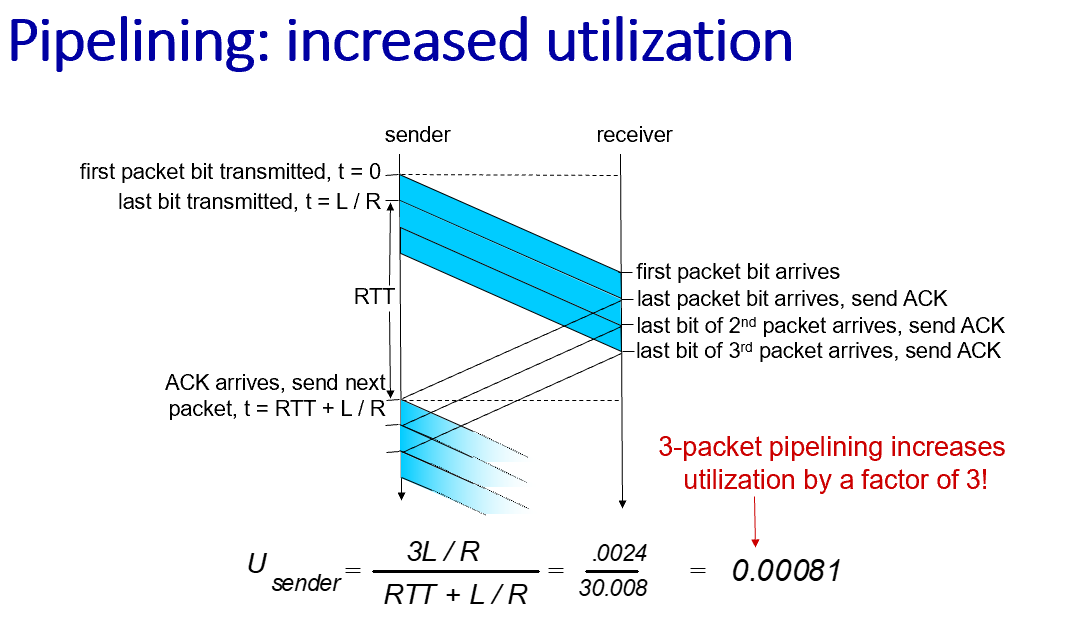
What must happen to the sequence numbers if we are pipelining?
Range of sequence numbers must be increased
Originally we used one bit for the sequence number (remember FSM), but with pipelining we need to increase the number of bits b/c we’re sending multiple packets
Besides adding bits for the sequence numbers, what other changes does pipelining cause?
buffering at sender and/or receiver (to receive multiple packets, buffer lets us send data back)
Go Back N is a pipeling protocol.
explain how it works.
Go Back N contains a window from the sender side with unACKed packets
As we receive acknowledgements in order, we shift the window
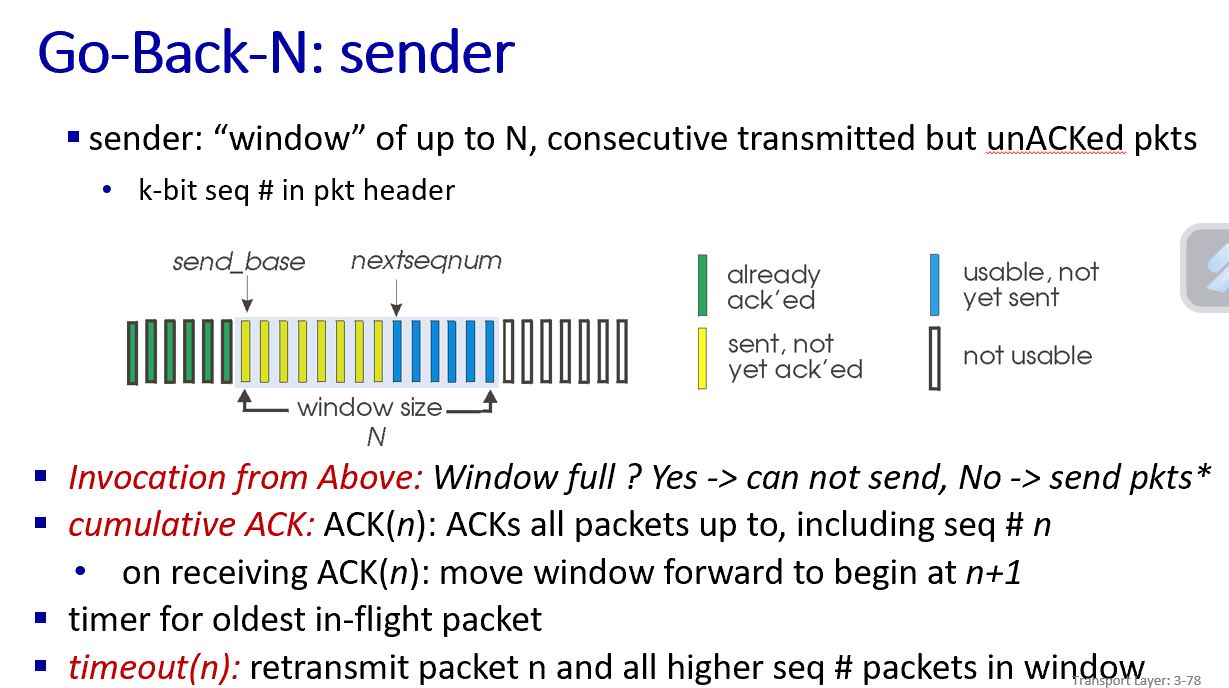
How does the window work in the Go Back N sender?
if the window is full, we cannot send
If it isn’t then we can send more packets
How do cumulative acknowledgements work for Go Back N?
Acks all packets up to, including sequence number n
on receiving ack(N)< move window forward to begin at n + 1
What is the timer on for the Go-Back-N sender?
timer for oldest in-flight packet
How does the time out work for Go Back N sender?
retransmit packet n and all higher sequence number packets in the window
Within Go Back N sender, what does send-base represent?
the smallest sequence number for the oldest unack packet

Give the ranges for all colors of the window
already ack’ed
sent, not yet ack’ed
usable, not sent
not usable
green = [0, send_base - 1]
sent, not yet ack’ed = [send_base, ns-1]
usable, not yet sent = [ns, send_base + n - 1]
Not usable range = [ >= send_base + n]
Oh no, what if timer times out?
sender will resend all packets sent since the oldest unacknowledged packet
Go-Back-N: receiver
What happens if the packets come out of order?
we just let it time out and ask for retransmit
Disadvantage of go back n receiver
extra time retransmitting packets, better to buffer out of order packets

What is MSS?
Maximum segment size
(Sequence number on both sizes. Have buffer to determine receiving window as well for sender)
MSS is just how much data we can take
An alternate Ack mechanism would be for the receiver to individually acknowledge specific packets as they are received. What is this called?
selective repeat protocol
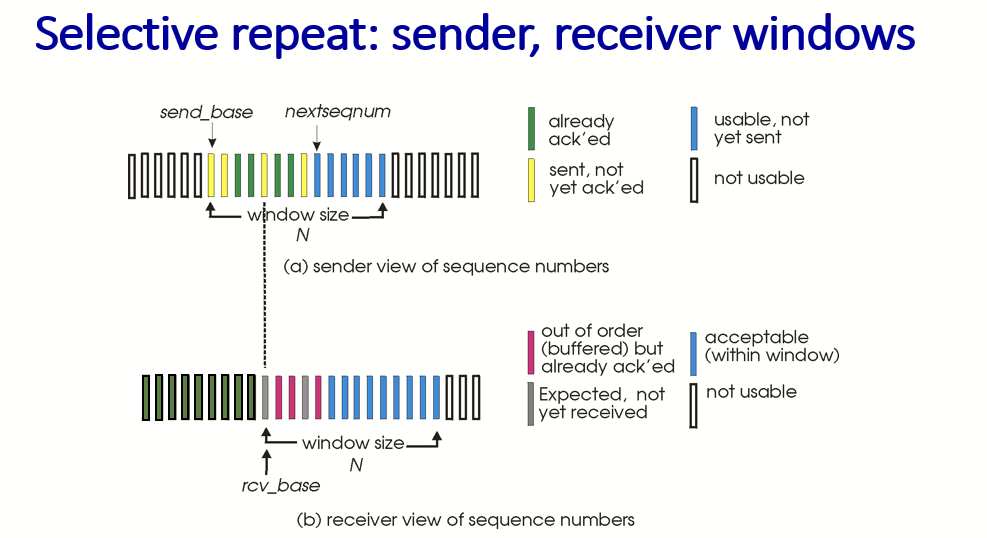
How does the selective repeat protocol work?
receiver individually acknowledges all correctly received packets
buffers packets as needed
sender times out and retransmits individually for unAcked packets
timer for each unAcked packet
sender window has N consecutive seqeunce numbers
limits sequence #s of sent for unAcked packets
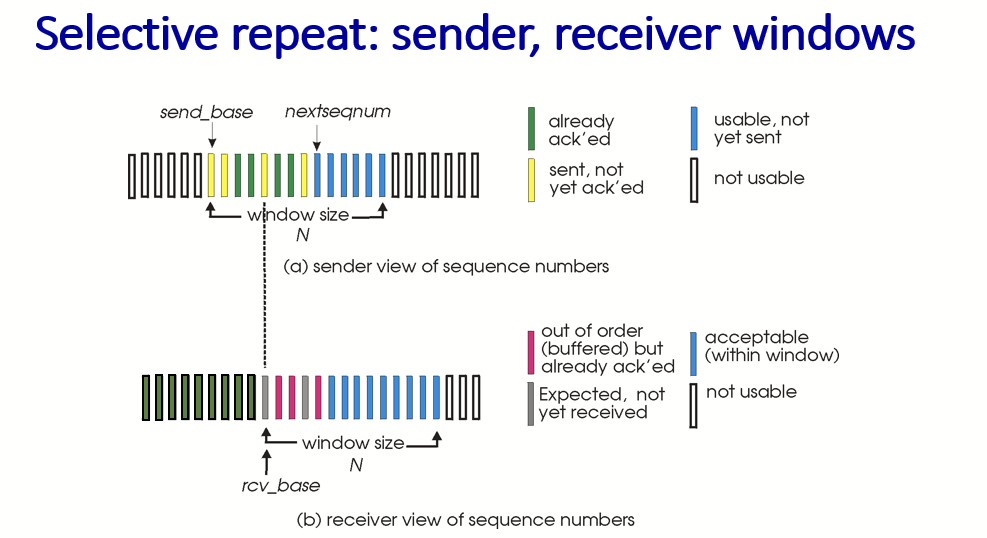
range for ack(n) packets for sender side
range for packet n in receiver side (window)
range for packet n, to acknowledge
range for ack(n) packets for sender side: [sendbase, sendbase + N]
range for packet n in receiver side = [rcvbase, rcvbase + n - 1]
Packet n in = [rcvBase - N, rcvbase - 1]
![<p>range for ack(n) packets for sender side: [sendbase, sendbase + N] </p><p></p><p>range for packet n in receiver side = [rcvbase, rcvbase + n - 1] <br><br>Packet n in = [rcvBase - N, rcvbase - 1] </p>](https://knowt-user-attachments.s3.amazonaws.com/2ad08dc7-0c08-41e5-a82b-e3f53928959f.png)
For selective repeat in action, what happens if a packet is lost?
it times out and the sender ONLY sends the missing packet, waiting for the matching acknowledgement
In TCP, what happens after a three way handshake?
sender and receiver establish parameters.
Sender establishes its own sequence number, receiver also sends sequence number
Sender and receiver decide buffer
When sender wants to send the data, data goes through send buffer. TCP does not specify when TCP will fetch/send data from buffer. It’s based off of TCP availability. TCP grabs the MSS. (Max transferable unit that the link layer can send. Link layer will send max size of frame it can send, and based off of that MSS is decided)
MSS is only application data, it is not transport header layer involved
Number of pacekts generated based off of MSS and filesize
size/MSS
(sequence number of first byte is zero)
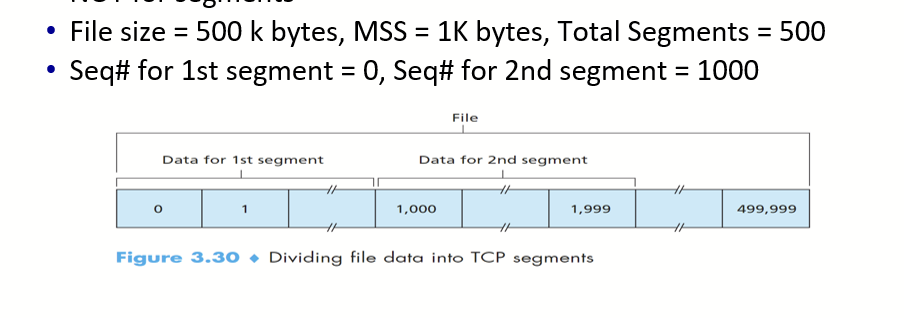

TCP sequence numbers with telnet scenario (echoes back)
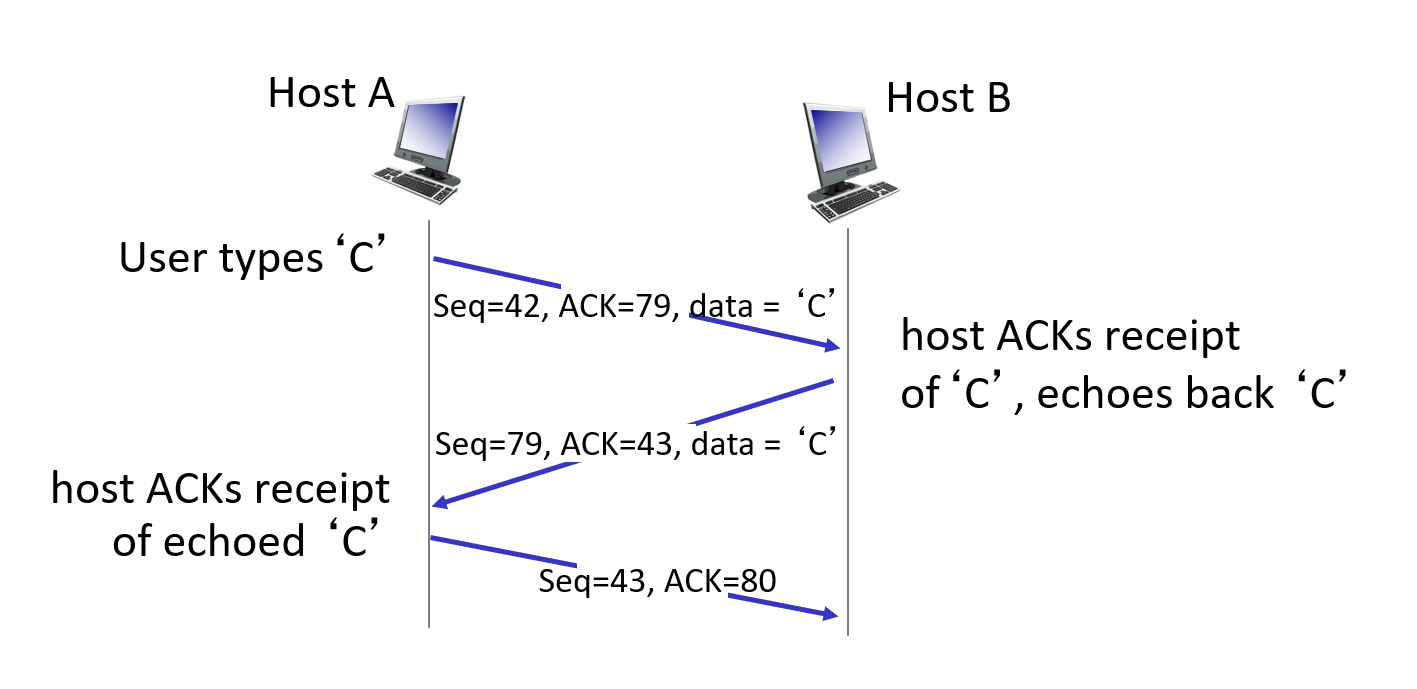
How to set TCP timeout value?
longer than RTT but RTT varies
If too short → premature timeout → unneessary retransmissions
if too long → slow reaction to segment lost
How to estimate RTT?
Sample RTT (measured time from segment transmission until ACK receipt)
- average of multiple measurements not just sampleRTT
How does TCP recompute the estimated RTT each time a new sampleRTT is taken
-
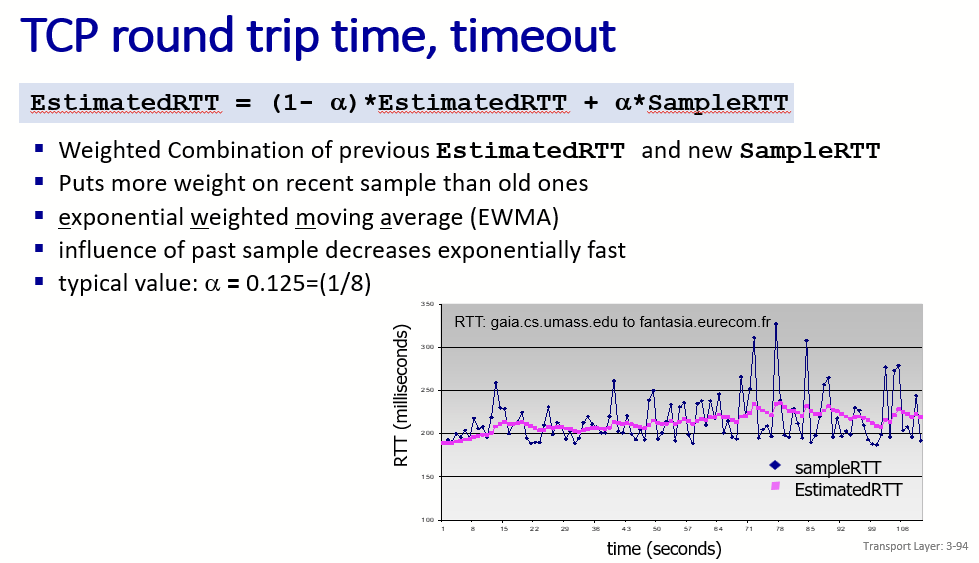
Given this value of the estimated RTT, TCP computes the timeout interval to vbe the estimated RTT plus a safety margin.
So, if we see a large variation in SampleRTT, the RTT estimates are fluctuation a lot, so we’ll want what type of safety margin?
a larger safety margin
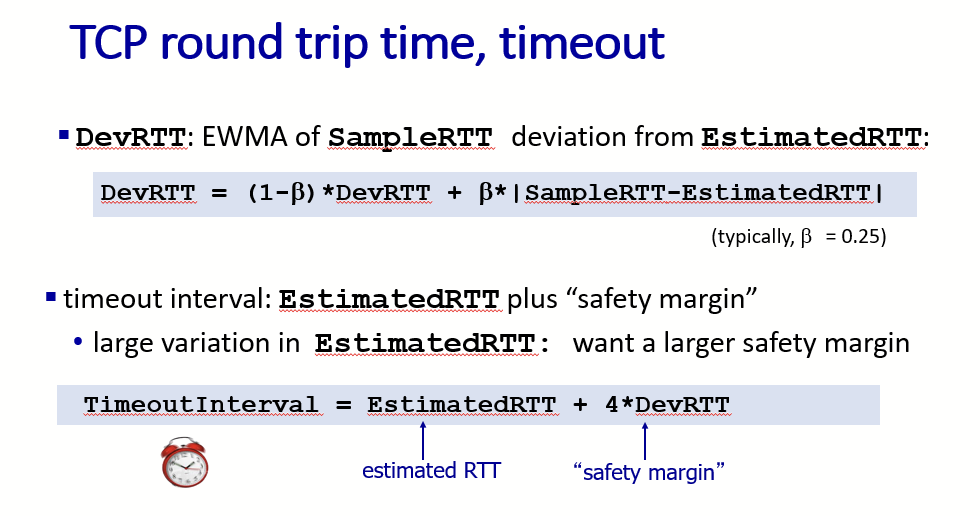
The segment number is what number?
byte stream number of first data byte in the segment
Scenario, what does TCP receiver do?
Event:
arrival of in-order segment with
expected seq #. All data up to
expected seq # already ACKed
delayed ACK. Wait up to 500ms
for next segment. If no next segment,
send ACK
Scenario, what does TCP receiver do?
Event:
arrival of in-order segment with
expected seq #. One other
segment has ACK pending
immediately send single cumulative
ACK, ACKing both in-order segments
Scenario, what does TCP receiver do?
Event:
arrival of out-of-order segment
higher-than-expect seq. # .
Gap detected
immediately send duplicate ACK,
indicating seq. # of next expected byte
Scenario, what does TCP receiver do?
Event:
arrival of segment that
partially or completely fills gap
immediate send ACK, provided that
segment starts at lower end of gap
What is TCP fast retransmit and why is it needed?
Time-out period is often really long before packet is resent, so we detect the lost segments via duplicate ACKs
- if sender sends many segments back to back, then resent b/c if segment lost, there will be a lot of duplicate ACKs
If sender receives 3 additional ACKs for the same data, resend unACKed segment with smallest sequence number
no need to wait for timeout if we have those duplicates
What is flow control?
– it allows the RECEIVER to explictly control the SENDER so sender won’t overflow receiver’s buffer by transmitting too much, too fast
(network layer delivers data faster than application layer removes data from socket buffers)
rcvBuffer stands for…
number of bytes associated with the buffer
Rwnd stands for…
receive window
Last Byte read stands for…
sequence number of last byte read from receiver buffer
Last byte received
sequence number of last byte placed in receiver buffer
How to tell how much received buffer is occupied?
last byte received - last byte read
How much of the received buffer is empty?
rcvBuffer - |LBrcved - LBread|
How to find the rwnd?
rwnd = RcvBuffer – [LastByteRcvd – LastByteRead]
In TCP flow control, what happens when Receiver advertise rwnd = 0 and no data to send?
Sender will not send data and will know when buffer opens up again if rwnd = 0 and no new data to send. No way to tell A the new capacity b/c A still thinks B is still full
Solution: even tho B send rwnd = 0, A will still send 1 byte of data to B. If the buffer has capacity available, it will read data and send packet back, so we have new capacity available to A (that A knows about).
flow control
number of bytes receiver willing to accept
(how much buffer space is available at receiver side)
On the sender side, what does the sender consistently have to run?
§LastByteSent – LastByteAcked <=rwnd
How can congestions occur?
Lost packets
buffer overflow at routers
Long delays
queuing in router buffers
Two approaches to congestion control
end-end congestion control
network-assisted congestion control
Describe end-end congestion control
no explicit feedback from network
conegestion inferred from end-system observed loss, delay
approach taken by TCP
router will enable bit from one router to another router, before being received by receiver. Receiver understands router is congested and sends back to sender that router is ocongestion
Describe network-assisted congestion control
routers provide feedback to end systems
single bit indicating congestion (SNA,DECbit, ATM)
explicit rate for sender to send at (sophisticated info, send at Mbps to solve congestion)
choke packet + sophisticated
Explain TCP Congestion control:
Additive increase
Multiplicative decrease
TCP Congestion Control
Sender increases transmission rate (window size), probing for usable bandwith until loss occurs
Additive increase
increase cwnd by 1 MSS every RTT until loss detective
Multiplicative decrease
cut cwnd in half after loss
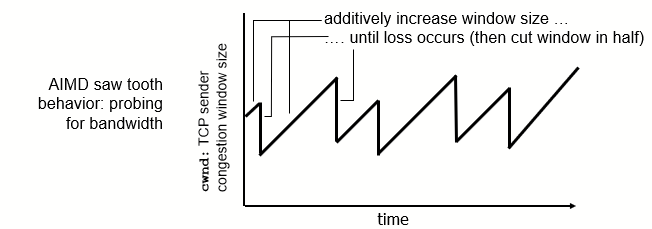
True or false: does sender have rwnd?
NO, sender has congestion window (cwnd)
is NOT part of TCP header
What does the cwnd do?
impose a constraint on the rate at which a TCP sender can send traffic into the network
the amount of unacknolwedged data at a sender may not exceed the minimum of cwnd and rwnd, show equation

TCP sending rate
send cwnd bytes, wait RTT for ACKs, then send more bytes

How does TCP sender determine which rate data should be sent?
Lost segment indicates congestion → sender’s rate should be decreased
time out or 4 additional duplicate ack
Acknowledgement segment indicates network is delivering data and sender’s rate can be increased
Bandwidth probing
TCP strat to incrase rate in response to arriving ACK until loss event occurs, then decrease sender’s rate
Stages to TCP congestion Control Algorithm
Slow start
Congestion avoidance
Fast recovery (optional)
Describe TCP slow start
when connection begins, increase rate exponentially until first loss event
initially cwnd = 1 MSS
double cwnd every RTT
done by incrementing cwnd for every ACK received
grows exponentially (slow start) then we slash it once congestion occurs, then half it
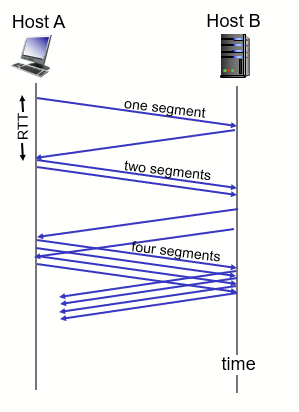
WHen do we go from slow start to fast recovery state?
when the loss indiciated by 3 duplicate acknolwdgement comes
when should the exponential increase switch to linear?
(slow start)
when cwnd gets to ½ its value before timeout
IMplementatino of switching slow start to contro lalgorithm
on loss event, ssthresh is set to ½ of cwnd just before loss event
TCP Tahoe vs TCP Reno
when loss occurs with slow start, TCP Tahoe has CWND set to 1 MSS
TCP Reno slashes it in half
What’s the point of ssthreshold?
it kind of acts as our constraint.
CWND just turns consistent, does not surpass ssthresh and we continue to send data linearly